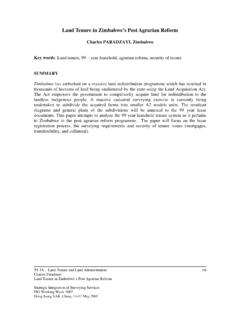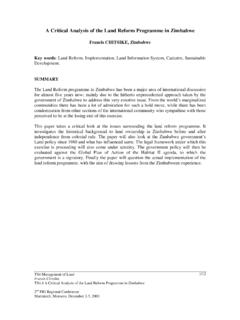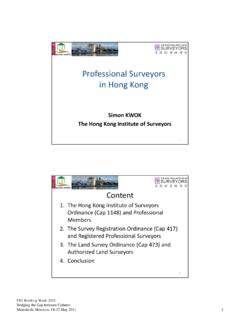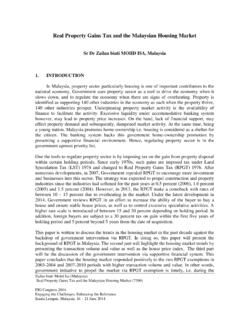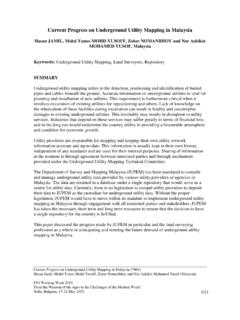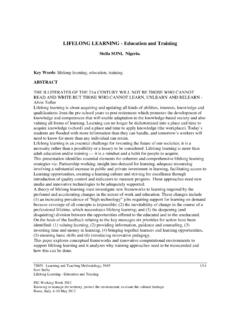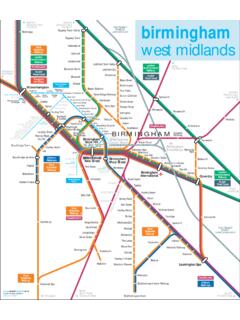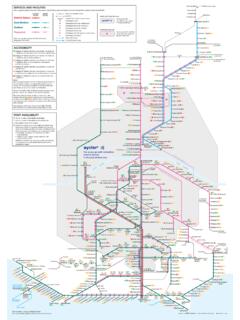Transcription of Predicting Construction Duration of Building Projects
1 Predicting Construction Duration of Building Projects Joe MARTIN, Theresa Keoughan BURROWS and Ian PEGG, United Kingdom Key words: Construction Duration , forecasting, key performance indicators (KPI), time. SUMMARY. This research is based on the analysis of the actual time' taken to construct buildings in the UK. The objective is to provide a tool to aid clients and their consultants in estimating or benchmarking the Construction Duration at the earliest stages of future Projects . Time predictability has been identified as one of the key performance issues to be addressed in providing best value to Construction clients. Following feedback on previous research in this area this paper describes the development of the tool to predict the likely Construction Duration of a project based on a set of known variables: Construction Duration Project sector Building type Procurement route Contractor selection method Client type Contract value Building function TS 28 Construction Economics I 1/13.
2 Joe Martin, Theresa Burrows and Ian Pegg Predicting Construction Duration of Building Projects Shaping the Change XXIII FIG Congress Munich, Germany, October 8-13, 2006. Predicting Construction Duration of Building Projects Joe MARTIN, Theresa Keoughan BURROWS and Ian PEGG, United Kingdom 1. INTRODUCTION. Significant Contract overruns are almost invariably traced to weaknesses on the part of the client as opposed to the professional consultants and contractors engaged to deliver the project. The most common deficiencies are weak client briefing and frequent client changes during the design and Construction phases' [6]. As part of the initial briefing process the client will normally have some idea of their desired timescale. Consultants, both in house and external have always used their experience to provide a reality check on these perceptions, to provide advice on realistic timescales or on the ramifications of sticking to faster programme.
3 This paper reports on research in the UK to provide benchmark data to back up this advice and explores its relevance in the USA. Various studies produced for the UK Government have highlighted poor prediction of client costs and Construction Duration period as key problems for the Construction sector. The Egan report Rethinking Construction [4] specifically recognised such issues stating: ( Construction ) Projects are widely seen as unpredictable in terms of delivery on time, within budget and to the standards of quality expected.'. Rethinking Construction proposed a specific set of performance measures be developed as Key Performance Indicators (KPIs) including measures of time and cost predictability. BCIS has been involved in the development of these since their first publication in 1999.
4 The latest set available where published by Constructing Excellence in 2005 [2] and data collection is underway for the 2006 KPIs. To date, the KPIs demonstrate that the industry's ability to predict the time a Building will take to construct is considerably worse than its ability to predict how much it will cost. The 2005 KPIs show that while some 20% of Projects experience increased costs over the Construction period, nearly 40% overrun their agreed contract period. There are two possible reasons for this: - increases in time taken, unlike increases in costs, always affects the predictability - the lack of information on the actual time taken on Projects . Increased costs that occur during a Building project will be allocated between the client and the contractor in accordance with the terms of the contract.
5 Therefore they may, or may not, affect the predicted cost. TS 28 Construction Economics I 2/13. Joe Martin, Theresa Burrows and Ian Pegg Predicting Construction Duration of Building Projects Shaping the Change XXIII FIG Congress Munich, Germany, October 8-13, 2006. Time is much less flexible. Whoever is responsible for a delay, and even if financial settlement is made, the client receives his completed project later than predicted. There are, of course, a multiplicity of factors that will affect the time taken to construct a particular project, such as: - Phasing - Design - Site access - Site conditions - Market constraints or opportunities - Complexity - Availability of resources - Availability of finances However, many of these factors will be unknown when early advice is required. Based on information collected to produce the time predictability KPI BCIS undertook some research in2004 looking at the relationship s between actual Construction period size of project and some other known variables.
6 The results were published in the BCIS Guide to Building Construction Duration [1]. The Guide also contained a calculator that produces estimates of likely Construction Duration based on a multiple linear regression model. 2. FEEDBACK FROM PREVIOUS RESEARH REPORT. The research report was well received but it was the calculator that prompted most interested. The major feedback points from users in the UK were: That the functional grouping variables were too broad eg. Administrative, Commercial, Protective Facilities' included offices and retail. Health, Welfare Facilities' included hospitals, clinics and homes. Residential Facilities' included houses, flats and hotels. The adjusting of future costs to the model cost base, 2nd quarter 2003 using time limited forecast figures as the default has required some external calculations to provide the required input data into the calculator.
7 What the client actually wants to know is how long will it take to deliver the project not just the Construction period. There were one or two disgruntled purchasers who, in spite of our best efforts to make clear that it was a tool for providing early advice to clients, expected it to be a planning (scheduling) tool. Our own internal review suggested that we should test further transformations of the data to provide a best-fit model. The final transformations in the existing model were the TS 28 Construction Economics I 3/13. Joe Martin, Theresa Burrows and Ian Pegg Predicting Construction Duration of Building Projects Shaping the Change XXIII FIG Congress Munich, Germany, October 8-13, 2006. square root of the Duration , the log of the contract sum, the square root of the log of the contract sum was also incorporated as a further parameter.
8 As a result of this feedback we are updating the study based on an expanded data set including a larger sample of Projects to produce a new calculator for the UK. 3. DATA. The data used in this study was collected from Construction industry clients and consultants as part of the annual Key Performance Indicators survey carried out by BCIS on the behalf of the Department of Trade and Industry (DTI). The data set analysed was a subset of the full KPI data set: The study is based on over 2,700 Building Projects completed in the UK between 1998. and 2006. Only new build Building Projects were included. Infrastructure, refurbishment, and repair and maintenance Projects are excluded. Projects for which some of the project variables were missing were excluded. The KPIs record data at three points.
9 A: Commit to invest Client sanction B: Commit to construct Start on site C: Available for use Construction completion Figure 1: Key project Stages for KPIs K. Keeyy P. Pro roje jecctt S. Sta taggeess A. A B. B C. C. CCoommm mitit to to CCoommm mitit to to AAvvaaila ilabble le In Invveesstt CCoonnsstru trucctt fo forr UUssee DDeessig ignn CCoonnsstru trucctio tionn CClie lienntt SSta tartrt oonn CCoonnsstru trucctio tionn SSaanncctio tionn SSite ite CCoommppleletio tionn Building project Duration is defined as the period between the date of client sanction to the project and the date of practical completion, in weeks' (A-C). Building Construction Duration was defined as the period of time between the date of the Construction contract start on site and the date of practical completion, in weeks' (B-C).
10 To eliminate the effect of regional variations in Construction costs, all costs were adjusted to UK mean location using the BCIS Regional Location Factors. Similarly, the total TS 28 Construction Economics I 4/13. Joe Martin, Theresa Burrows and Ian Pegg Predicting Construction Duration of Building Projects Shaping the Change XXIII FIG Congress Munich, Germany, October 8-13, 2006. Construction costs derived from the DTI data were adjusted to a base date using the BCIS. Tender Price Index to remove the effect of time related cost change. Total Construction cost was defined as the final amount paid to the contractor at the base date, UK mean location prices excluding VAT and consultants fees.'. The known variables and their classification for the Projects in the sample are: Variable Project Sector Classification o Private housing o Public housing o Private non-housing o Public non-housing As defined in DTI Construction Statistics [5].
